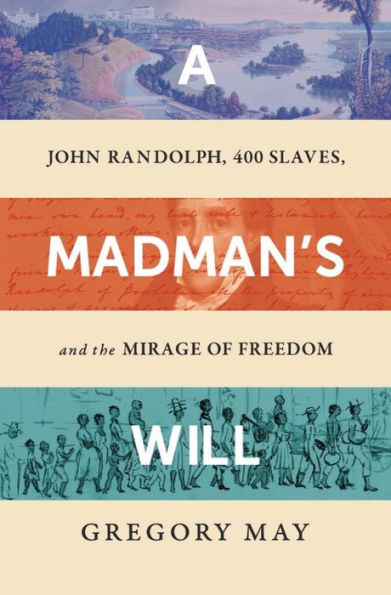A Madman’s Will: John Randolph, 400 Slaves, and the Mirage of Freedom
- By Gregory May
- Liveright
- 416 pp.
- Reviewed by Eugene L. Meyer
- April 14, 2023
Was manumission an escape or an illusion?

Was John Randolph — the fiery and erratic U.S. senator from Virginia who sometimes believed in abolition and sometimes didn’t — a rational man? Or was he legally insane when he granted freedom to his 383 enslaved people? That’s the question at the heart of Gregory May’s intriguing A Madman’s Will, which adds fresh scholarship to what Swedish sociologist Gunnar Myrdal once called “the American Dilemma.”
But it’s not the only question. Of equal and more abiding importance: What happened to the newly emancipated after they reached the promised land of Ohio, an alleged “free” state? Nothing good, it turns out.
“They have no feeling for colored people in Ohio,” remarked John White, Randolph’s once-enslaved manservant, as he and his family made their way back to Virginia. When the freed people’s efforts to sink roots up North largely failed, many of them, like White, opted to return to the world they knew best, the Virginia Piedmont, either re-enslaving themselves or counting on the laws of the commonwealth to look the other way.
Randolph had, in fact, added a codicil to his will allowing his liberated slaves to remain in Virginia, but that contravened a state law — enacted in 1806 but seldom enforced — which decreed that the formerly enslaved must leave the state within a year of their manumission.
A Madman’s Will traces the trajectory of Randolph’s controversial will, from its first draft, in 1800, asserting his desire that “every individual negroe” he owned “be restored to that freedom which is his just & natural right and of which he has been so long & basely deprived,” through subsequent versions in 1819 and 1821, and up to the final edition he signed, his health failing, after returning from a brief post as U.S. minister to Russia. Hoping for a healing trip to England, Randolph died in Philadelphia on May 24, 1833, before he could set sail.
Randolph’s ambivalence about the institution of slavery adds complexity and nuance to his biography. In Congress, he defended slavery on the basis of states’ rights even as he criticized it on moral grounds. He was keenly aware of its divisive implications, noting that “the line of severance,” should the Union dissolve, “would be between the slave-holding and non-slaveholding States.”
Some larger context is useful here: Many 19th-century slaveholders lamented the peculiar institution but only in the abstract. Too much of their wealth was invested in human bondage, and slaves were often used as collateral for loans, which had to be paid in full before those slaves could legally be freed. Some enslavers, aware of the institution’s inhumanity, favored colonization — exporting the manumitted to Africa — as both an ethical and practical solution. May notes that in the antebellum South, a will freeing slaves was more for the benefit of white heirs than for the enslaved themselves. But Randolph’s case was unique.
His final will oddly made no mention of manumission and named a young nephew he barely knew as his sole heir. But as Randolph lay dying, he told the attending physician of his desire to free his slaves, a deathbed declaration of dubious legal standing.
Randolph’s death was the precipitating event that led to 13 years of litigation, trial, and, ultimately, a jury judgment that freed his slaves. It may have been, as advertised, “a celebrity trial,” but on paper, it’s dry drama at best. This middle section — about a third of the book — is full of legal ins and outs, along with secondary and tertiary characters. Even with a family tree preceding the preface and an appendix identifying 53 persons and nine places, the book’s cast of characters is difficult to follow. More summary and less detail might’ve helped, as would a map of Virginia for locating key sites.
May, a Harvard Law School graduate who clerked for U.S. Supreme Court Justice Lewis Powell and practiced law in New York and Washington, DC, for more than 30 years, seems well-suited to the task of sorting it all out. But his background might have prompted his descent into murky legal waters here at the expense of narrative flow.
The book’s protagonist, of course, is the eccentric Randolph, who dies on page 15. The rest is prologue and afterword, as the author opens his story on the tobacco plantations of Piedmont Virginia, which were economically dependent on slave labor, and closes it with the enslaved gaining their liberty. A happy ending, you’d think.
But May’s own conclusions might surprise readers who view manumission through a sympathetic lens. “Before every person had a legal right to freedom, the gift of freedom was not liberating,” he writes. “Because manumission was just an exercise of the giver’s rights, it changed almost nothing.” Further, “A man who released the workforce his family needed was more likely to be called mad than righteous.”
By that standard, John Randolph, whose heirs no doubt needed that workforce, could rightly be called “a madman.”
Eugene L. Meyer, a member of the board of the Independent, is a journalist and author of, among other books, Five for Freedom: The African American Soldiers in John Brown’s Army and Hidden Maryland: In Search of America in Miniature. Meyer has been featured in the Biographers International Organization’s podcast series.

